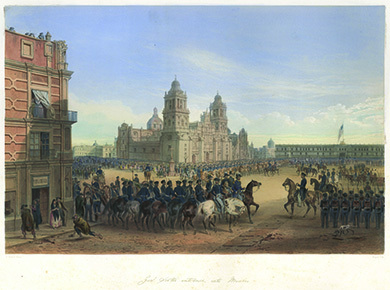| << Chapter < Page | Chapter >> Page > |
Scott captured Veracruz in March 1847, and moving in a northwesterly direction from there (much as Spanish conquistador Hernán Cortés had done in 1519), he slowly closed in on the capital. Every step of the way was a hard-fought victory, however, and Mexican soldiers and civilians both fought bravely to save their land from the American invaders. Mexico City’s defenders, including young military cadets, fought to the end. According to legend, cadet Juan Escutia’s last act was to save the Mexican flag, and he leapt from the city’s walls with it wrapped around his body. On September 14, 1847, Scott entered Mexico City’s central plaza; the city had fallen ( [link] ). While Polk and other expansionists called for “all Mexico,” the Mexican government and the United States negotiated for peace in 1848, resulting in the Treaty of Guadalupe Hidalgo.

The Treaty of Guadalupe Hidalgo, signed in February 1848, was a triumph for American expansionism under which Mexico ceded nearly half its land to the United States. The Mexican Cession , as the conquest of land west of the Rio Grande was called, included the current states of California, New Mexico, Arizona, Nevada, Utah, and portions of Colorado and Wyoming. Mexico also recognized the Rio Grande as the border with the United States. Mexican citizens in the ceded territory were promised U.S. citizenship in the future when the territories they were living in became states. In exchange, the United States agreed to assume $3.35 million worth of Mexican debts owed to U.S. citizens, paid Mexico $15 million for the loss of its land, and promised to guard the residents of the Mexican Cession from Indian raids.
As extensive as the Mexican Cession was, some argued the United States should not be satisfied until it had taken all of Mexico. Many who were opposed to this idea were southerners who, while desiring the annexation of more slave territory, did not want to make Mexico’s large mestizo (people of mixed Indian and European ancestry) population part of the United States. Others did not want to absorb a large group of Roman Catholics. These expansionists could not accept the idea of new U.S. territory filled with mixed-race, Catholic populations.
Explore the U.S.-Mexican War at PBS to read about life in the Mexican and U.S. armies during the war and to learn more about the various battles.
The United States had no way of knowing that part of the land about to be ceded by Mexico had just become far more valuable than anyone could have imagined. On January 24, 1848, James Marshall discovered gold in the millrace of the sawmill he had built with his partner John Sutter on the south fork of California’s American River . Word quickly spread, and within a few weeks all of Sutter’s employees had left to search for gold. When the news reached San Francisco, most of its inhabitants abandoned the town and headed for the American River. By the end of the year, thousands of California’s residents had gone north to the gold fields with visions of wealth dancing in their heads, and in 1849 thousands of people from around the world followed them ( [link] ). The Gold Rush had begun.

Notification Switch
Would you like to follow the 'U.s. history' conversation and receive update notifications?